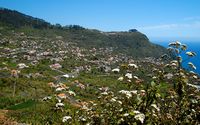 | The town of Calheta |  |
| |
| |  Etymology Etymology | The name of Calheta comes from a small split which was used formerly as port and which was named by the first colonizers of the island. “traversing the coast on two miles without finding where to unload, they transfer a great work where, eager to know the ground, they unloaded between the rocks, there built an unloading dock to which the captain the name of Calheta gave. ” Gaspar Frutuoso, 16th century |
|
| | | | | Excursions | | The town of Calheta gives access to the plate of Paúl da Serra and Rabaçal, where one finds the forest in his wild state. It is as since Rabaçal as one can carry out excursions in the splendid ones and impressive landscapes. It is possible to make the course of Calheta until Ponta do Pargo, while following the levada which leaves the hydroelectric station until Sítio do Cabo, to Ponta do Pargo. The course which starts in Rabaçal passes by Lagoa do Vento, by Risco then by 25 Pig iron and cast iron, is also one of the attractions of the commune. | | Igreja Matriz de Espirito Santo | | Surrounded by jacarandas, the church of the Holy Spirit, built at the 17th century (1639), is flanked of a capped bell-tower of a sphere armillaire. | _small.jpg) _small.jpg) | | Its interesting ceiling of the chorus mudéjar out of wood of cedar, which can support the comparison with that of Sé de Funchal, covers the nave baroque. | _small.jpg) _small.jpg) | _small.jpg) _small.jpg) | _small.jpg) _small.jpg) _small.jpg) | | With the high altar, gate vault out of ebony encrusted with money. | _small.jpg) _small.jpg) _small.jpg) | | Hydroelectric station | _small.jpg) Water of the plate of Paúl da Serra, retained in a tank close to Rabaçal, provides their forces to the hydroelectric station of Calheta. Water of the plate of Paúl da Serra, retained in a tank close to Rabaçal, provides their forces to the hydroelectric station of Calheta. | | Marina | _small.jpg) _small.jpg) |
|
| |  History History | _small.png) Created in 1430, Calheta was one of the first places colonized and exploited at agricultural ends. Many personalities were in particular received there João Gonçalves Zarco which will choose grounds for his/her son João Gonçalves da Câmara and his daughter D. Beatriz. Created in 1430, Calheta was one of the first places colonized and exploited at agricultural ends. Many personalities were in particular received there João Gonçalves Zarco which will choose grounds for his/her son João Gonçalves da Câmara and his daughter D. Beatriz.D Besides Beatriz will make there build the vault of Nossa Senhora da Estrala, which had been planned by his/her father. |
|  Economy Economy |  The major part of the population, for a long time, was devoted to the agricultural activity, and in particular to the production of banana, the wine, the cane with sugar like with the horticulture. By the richness of the parish church, one realizes of the fortune which sugar brought to the first merchants of the island. The major part of the population, for a long time, was devoted to the agricultural activity, and in particular to the production of banana, the wine, the cane with sugar like with the horticulture. By the richness of the parish church, one realizes of the fortune which sugar brought to the first merchants of the island.Very close to Calheta, one can discover the vestiges of the one of the many sugar refineries of yesteryear to the center even of the locality, Engenhos da Calheta still fill their office and produce a brandy which one can buy on the spot. Thereafter, the industrial sector took an increasingly important place, with mainly the small milk industries, of fireworks, salt and sugar. Currently, only the factory of fireworks of Lombo do Doutor, and the industry of sugar remain: the press for the manufacture of honey and brandy is always in activity in the borough of Calheta. |
|  Traditions Traditions | Principal festivals of the commune:- Celebrates of Saint Antoine (Santo Antão), owner of the animals, takes place with Prazeres on January 18th. With the program, blessing of the animals and procession with the image of Saint Antoine.
- Festivals of the commune of Calheta the day of the Jean Saint, on June 24th: The festivities proceed in the parish of Calheta and last one week (concerts, exposures, fire of artifices, plays sporting, ravelled etc).
- Celebrates of Nossa Senhora do Loreto: fun fair which proceeds on September 8th. With the program: folk groups, philharmonic bands, meat skewers made with wood of bay-tree, cake to the garlic butter, beer with orangeade etc
- Celebrates Apple (Festa do Pêro) carried out with Ponta do Pargo the second fortnight of September, where the various uses of apple are shown. This festival of agricultural nature lasts 2 days.
|
|
| | |  Restaurants Restaurants | | The tuna, the mackerel, the black swordfish, the sweet potato, potatos of but, lapped them roasted with lemon juice, the winkles, the skewers of beef “espetada”, the meat with the wine, the meat picanha, the bread buttered with garlic “bolo do caco” etc Calheta is also known to make the best white rum, aguardente, a specific ingredient of typical the poncha madérienne. One can visit Engenhos da Calheta, the rum distillery where one can discover and taste the white rum. |
|
| | |
|
 Situation
Situation Visits
Visits History, literature, arts, traditions, legends, religions, myths, symbols…
History, literature, arts, traditions, legends, religions, myths, symbols… Practical informations
Practical informations Other topics
Other topics_small.png)

_small.jpg)
_small.jpg)
_small.png)
_small.jpg)
_small.jpg)
_small.jpg)
_small.jpg)
_small.jpg)
_small.jpg)
_small.jpg)
_small.jpg)
_small.jpg)
_small.jpg)
_small.jpg)
_small.jpg)
_small.jpg)
_small.jpg)
_small.jpg)
_small.png)

_small.jpg)
_small.jpg)
_small.jpg)
_small.jpg)
_small.jpg)
_small.jpg)
_small.jpg)
_small.jpg)
_small.jpg)